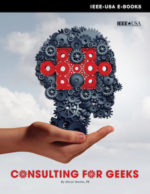Simplify your expertise…
This post was inspired by a recent post from fellow AZ blogger (and person I have long admired) Pamela Slim. She started off with this quote, which I borrowed:
“In the beginner’s mind there are many possibilities, but in the expert’s there are few.” ― Shunryu Suzuki
It got me thinking about our roles as consultants. Most of us have wide knowledge and experience in our area of expertise. As such, we could offer many possible solutions to the problems faced by our clients.
But our real value is the ability to winnow those possibilities down to a select few, and then make recommendations. Much like a doctor (also a professional consultant) who makes a diagnosis followed by a prescription or recommended course of action.
So how do you do this? You begin by asking questions, and then carefully listening to those answers. Those answers may lead to more questions, so you dig deeper.
As a consulting engineer, I’ve long followed a methodology used by medical doctors known as differential diagnosis. First heard this from a client whose brother was an MD. As we were troubleshooting his problem, he shared this approach he had learned from his brother.
Later, I had a chance to expand my understanding thanks to an MD from the Mayo Clinic. An airplane seat mate, I asked about the term. As a teaching doctor, he broke into a big smile and shared his knowledge (and wisdom) as we flew across the country. The flight was most memorable, and has since influenced consulting approach.
The goal is to “rule things in – rule things out.” For example, the Mayo MD said, if a patient presents with a red rash, there may be a hundred possible causes. But with some additional information (such as vital signs or simple questions) one may be able to quickly reduce this to but a few possibilities.
Based on that, you begin by treating the most likely cause. Even then, you are playing the probabilities, so if the initial treatment does not solve the problem, move to the next most likely solution. Or, as mom and dad used to say, “If at first you don’t succeed, try again…”
I have since modified the approach. Rather than prioritizing solely on probabilities, I first try the very simple solutions. Learned this after spending several days trying most likely solutions, while ignoring an easy low probability solution that worked. A bit embarrassing.
Doing this also gives rise to an occasional consulting miracle. For example, even if the simple solution has a 1% probability of success, that still means that one out of a hundred times it works. And when it does, everyone thinks you are a genius. 🙂
Finally, don’t just treat the symptoms — seek to treat the cause. The goal is to not only understand the problem, but to identify the underlying root cause of the problem. Asking questions, digging deeper, and using differential diagnosis all help.
We’ll dig deeper ourselves in a future post on the “Five Whys'”.
This post precipitated a new category — troubleshooting — where I will share more insights on this important facet of consulting.
Join us for our next FREE monthly teleconference.
“Ask Daryl Anything About Consulting”
Register Here
© 2018 – 2019, https:. All rights reserved.
Leave a Reply Cancel reply
- Read All Posts - Start Here
- 20 Ways to Attract Clients
- Top 10 Reasons to Consult
- Top 10 Reasons NOT to Consult
- Management vs Tech Consulting
- Seven Steps in Selling
- Five Steps in Marketing
- How We Made $15 Million in Training Classes
- How We Sold 130,000 Books In Only One Day
- Financial Independence
- How Much is Enough?
- Consulting in Retirement
- Why Critics Don't Count
- An Ode To My Better Half
- In Memory-Bill Kimmel
- EMIGURU-My Consulting Website
- Anecdotes & Musings (165)
- Encouragement (84)
- Mailbag (1)
- Encouragement (84)
- Boomers (18)
- Geeks (23)
- General Consulting (153)
- Administration (11)
- Financial (24)
- Marketing (64)
- Sales (19)
- Mailbag (14)
- Rants (20)
- Resource Reviews (21)
- Success Stories (22)
- Troubleshooting (6)
- Uncategorized (43)







One Response to Simplify your expertise…